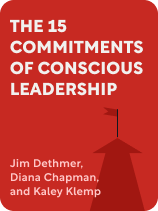

This article is an excerpt from the Shortform book guide to "The 15 Commitments of Conscious Leadership" by Jim Dethmer, Diana Chapman, and Kaley Klemp. Shortform has the world's best summaries and analyses of books you should be reading.
Like this article? Sign up for a free trial here.
Why is emotional intelligence important for leaders? How can you manage your emotions?
The 15 Commitments of Conscious Leadership argues that to be an effective leader, you must understand and healthily manage your emotions. Failing to do so might lead you to repress and intensify your feelings, which can harm your well-being.
Let’s look at how to manage your emotions so you can be the best leader for your employees.
How to Understand and Manage Your Emotions
To fully understand how to manage your emotions, the authors recommend taking four steps:
Step #1: Understand What Emotions Are
First, understand what emotions are: ever-changing physical sensations that don’t define you, aren’t inherently “bad” or “good,” and aren’t something to fear. The authors explain that accepting these truths can help you resist the urge to repress your emotions—something many people do because they see certain feelings as “bad” or “inappropriate.”
(Shortform note: Some research suggests that viewing negative emotions more neutrally, as the authors suggest here, may improve your mental health in general (as well as helping you resist emotional repression). One study recorded higher levels of depression and anxiety in people who viewed negative emotions as “bad.”)
Step #2: Know the Main Emotions
Second, know the five main emotions: being happy, unhappy, scared, mad, and sexually aroused. The authors note that all other feelings stem from, are variations of, or are combinations of these emotions. Learning the main emotions is necessary because you must identify which emotion you’re feeling before you can perform the next two steps of emotional management—releasing the emotion and interpreting it.
(Shortform note: The authors suggest that we all experience five specific main emotions. However, this may not be true in certain cultures. In How Emotions Are Made, Lisa Feldman Barrett argues that different cultures have different emotions, as expressed through unique words describing emotion concepts that don’t exist in other cultures. For example, Tahitians don’t have the concept of sadness. Instead, they have the concept of “pe’ape’a,” which is a combination of the Western concepts of ill, troubled, fatigued, or unenthusiastic. Without the concept of sadness, you can’t experience sadness.)
Step #3: Release Emotions Through Action
Third, the authors suggest releasing your emotions by completing an action that aligns with and expresses what you’re feeling. Start by identifying where you’re feeling the emotion in your body—for example, being scared might feel like your heart is being squeezed. Then, take deep breaths. Finally, use an intuitive movement to release your feelings by listening to what the emotion is telling you to do. For example, fear might push you to do a loose, expressive movement to overcome the tightness in your chest—you might stretch or do some jumping jacks.
(Shortform note: While the authors suggest tailoring your movements to the specific emotion you’re experiencing, certain types of movement may help you to work through any strong emotion. For example, some yoga movements—like pigeon pose, child’s pose, supported twist, and savasana—may help you to physically, mentally, and emotionally process emotions and release tension.)
Step #4: Interpret Your Emotions
Finally, the authors recommend figuring out what your emotion is trying to tell you. Being mad means that something isn’t right and must be replaced or improved. Being scared means that you must learn a new skill to overcome whatever is threatening you. Being unhappy means that you’re losing something meaningful and you have to accept it and let it go. Being happy means that something needs to be celebrated. Being sexually excited indicates creativity and should inspire collaboration with others.
| Other Interpretations of the Five Emotions Other experts also offer interpretations of the meaning behind certain emotions. Let’s explore some of these alternative perspectives: Anger: Some experts agree that anger indicates something’s wrong and needs to change, adding that the emotion usually stems from underlying feelings of fear, loss, or sadness. Others argue that anger is always a reaction to feeling hurt in some way—this could be physically (in the case of illness or the prospect of injury) or emotionally (for instance, if someone has rebuffed or insulted you). Being scared: Fear usually is a psychological response to feeling threatened in some way. Sometimes, this threat is only perceived rather than real—for instance, in the case of some phobias. In this case, it may be helpful to learn a new skill to overcome the source of your fear: For example, you may attend counseling to learn how to manage your phobia. However, fear can also indicate that you’re in a truly dangerous situation that you must escape. In these situations, fear is telling you to fight or run to protect yourself—trying to adapt to tolerate the situation could be dangerous. Unhappiness: Some people agree that sadness indicates we’ve lost something important to us. They add that we express unhappiness to signal that we need support from others to process our painful emotions. That support can take various forms—we might want another person to actively help us through the difficult situation. Or, we might want others to give us the space we need to process the event in our own time. Happiness: Some experts note that happiness is notoriously nebulous and hard to interpret. They suggest that happiness is usually a direct result of strong well-being, which encompasses five main areas: emotional well-being, physical well-being, social well-being, workplace well-being, and societal well-being. Sexual feelings: Typically, experts interpret sexual feelings as a sign of arousal or attraction, rather than a motivator of creativity or platonic collaboration. However, some research has linked sex and creativity—one study found that non-creative people have sex with fewer people than creative people. |

———End of Preview———
Like what you just read? Read the rest of the world's best book summary and analysis of Jim Dethmer, Diana Chapman, and Kaley Klemp's "The 15 Commitments of Conscious Leadership" at Shortform.
Here's what you'll find in our full The 15 Commitments of Conscious Leadership summary:
- Why many leadership models are unsustainable in the long term
- Why leaders must learn to understand and manage their emotions
- The 15 commitments that leaders must uphold to run an effective organization






